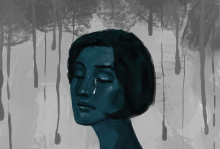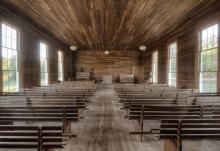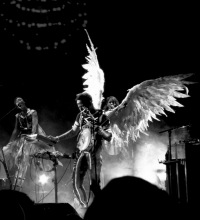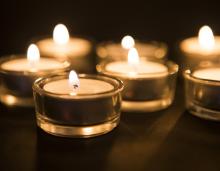A poem.
mourning

IN THE 15TH CENTURY, Margery Kempe received the divine gift of weeping. When considering the multitude of spiritual powers God has bestowed — prophecy, healing, and discernment, for instance — weeping is a peculiar one. After several transformative visions, Kempe, an English laywoman and mystic, wept regularly in hourslong sessions out of contrition for human fallenness and compassion for Christ’s suffering. St. Jerome visited her to convey that God had given her a permanent “well of tears” to help others. Consequently, she developed a form of sanctifying prayer, weeping “on others’ behalf” to help liberate them from sin, purgatory, anguish, or death. Kempe’s fervor continues to demonstrate the place of tears in daily life. Even for us non-ascetics, tears express truth, helping us attune to the wisdom within and beyond us.
Some of Kempe’s contemporaries thought her weeping (which evolved into a decade of “roaring”) to be disruptive, odd, or performative. And as Oxford professor of English Santha Bhattacharji explains in her article “Tears and Screaming: The Spirituality of Margery Kempe,” those critiques continue today. Some scholars have labeled Kempe as “extreme” or “hysterical,” characterizations that ring of misogyny. Nevertheless, her practices were church-approved and part of the well-worn tradition of Christian tears. The Desert Mothers and Fathers considered crying an “official form of worship.” The Rule of St. Benedict stipulates that tears are the mark of “pure prayer.” Tears — whether quiet or loud — are expressions of the heart that connect us to divine wisdom. As Eastern Orthodox theologian Kallistos Ware writes in his article “‘An Obscure Matter’: The Mystery of Tears in Orthodox Spirituality,” “We weep [to give] expression to the intimate feelings that are ‘too deep for words.’”

IN THE EARLY days of the pandemic, I started a death scroll. Not to be confused with “doomscrolling” (a malady related to one’s smartphone), my death scroll was a physical length of paper on which I penned names and death dates as I learned of them.
Across the top I scrawled: “Blessed are you, Lord Our God, Who Is Keeper of the Book of Life. Today, we learned that Sister Death called ...” On March 13, 2020, I wrote the first name: Barbara Clementine Harris. A towering figure in the American church, Harris registered Black voters in Mississippi in the 1960s, marched from Selma to Montgomery in 1965, and was one of the first 11 women “irregularly” ordained as Episcopal priests in 1974 and the first female bishop in the Anglican Communion. But, because of the COVID lockdown, no churchwide memorial service was held for her.
Pandemics bring death. And, as Christians, it’s impressed upon us to remember. Remember the Sabbath. Remember that your ancestors were slaves in Egypt. Do this in remembrance of me. Remember my chains. But ... I have a very bad memory. So, I made the scroll. When I stopped collecting names in late 2022, my scroll held 36. How many names would your scroll hold?

O God, we grieve the struggle of those who died alone —
so far from friends and neighbors, from all they’d ever known.
We grieve for precious people who could not say good-bye;
we weep for those, now mourning, who sit alone and cry.

What could it possibly mean to us that an endangered species of orca whales hold a mourning period after losing their young? While mourning is a natural habit of many creatures, we should pay attention to Tahlequah’s process of grief. Perhaps if we observe the creatures we have been called to care for and learn from, we might learn something about what it means to be human.

THE ART OF ... book series from Graywolf Press focuses on writing craft and criticism. In each compact volume an accomplished writer takes on a single element or theme. The most recent entry in the series is The Art of Death, by Edwidge Danticat.
Danticat’s reflections on a wide variety of literature that wrestles with death—from Taiye Selasi’s debut novel, Ghana Must Go, to C.S. Lewis’ A Grief Observed—offer insights for readers as much as for writers. She explores the complicated emotional landscape of death and mourning, but also the myriad ways, tangled in questions of both justice and mercy, that death comes: accident, illness, deadly disasters, suicides, executions.

A week after a terrorist bomb killed more than 20 and left scores injured, the people of Manchester will make their way through the streets of their grief-stricken city in one of its most traditional and religious events: the Whit Walk.
This will be a moment where the old Manchester meets the new, when the Christian tradition of the walk, commemorating the Feast of Whitsun — or Holy Trinity — meets the secular rituals that have come to define public mourning since this increasingly irreligious nation said goodbye to Princess Diana, who died exactly 20 years ago.

I arrived at the church and was heartened to see a full parking lot. People scurried inside with umbrellas as shields, determined to comfort Emily and her family. I’m right here for you, they seemed to be saying. Nothing's going to stop us. Where have we heard this before?

Sufjan Stevens’ newest album, Carrie & Lowell (out now), is a heartbreaking meditation on personal grief. It’s also joyful, baffling, and delicately mundane.
In the spirit of a listening party, a few of us sat down to play through the album, sharing liner notes and meditations on the songs that grabbed each of us. Conclusion: it's really, really good. Stream Carrie & Lowell here, and listen along with us below.
“Death With Dignity” — Tripp Hudgins, ethnomusicologist, Sojourners contributor, blogger at Anglobaptist
Tripp: I love the first song of an album. I think of it as the introduction to a possible new friend. “Where The Streets Have No Name” on U2’s Joshua Tree or “Signs of Life” on Pink Floyd’s Momentary Lapse of Reason, that first track can be the thesis statement to a sonic essay.
So, when I get a new album — even in this day of digital albums or collections of singles — a first track can make or break an album for me. I sat down and listened attentively to “Death With Dignity.” It does not disappoint. With it Stevens introduces the subject of the album — his grief around troubled relationship with his mother and her death — as well as the sonic palate he will use throughout the album.
Simple guitar work, layered voicing, and a little synth, the album is musically sparse. The tempo reminds me of movies from the nineteen sixties or seventies where the action takes place over a long road trip.
Catherine Woodiwiss: I was thinking road trip, too. There’s real motion musically, which, given a claustrophobic theme and circular lyrics, is a thankful point of release. It’s a generous act, or maybe an avoidant one — he could have made us sit tight and watch, and he doesn’t quite do it.
Julie Polter: This isn’t a road movie, but the reference to that era of films just made me think of Cat Stevens’ soundtrack for Harold and Maude, especially “Trouble.” (This album is one-by-one bringing back to me other gentle songs of death and duress and all the songs I listen to when I want to cry).
A YEAR BEFORE her death from ovarian cancer, my 78-year-old mother finally started losing weight. She gave up fatty foods and sweets and went to herbalists who sold her pills that were supposed to regulate her digestion. In addition to all this, she was seeing her primary physician every three months.
The weight flying off seemed like a reward for her good behavior. The only downside was that my mother, who now weighed less than me, was burping all the time, as if there was thunder trapped inside her ever-shrinking body.
At Christmas time, I invited her to come spend the holidays with me and my family in Miami. At first she said no. Her birthday was three days after Christmas and she wanted to spend it at her home in New York.
She changed her mind right before Christmas, and she cooked us a wonderful Christmas dinner, and we took her to one of our favorite Haitian restaurants for her birthday. At her birthday dinner, my two daughters performed a birthday dance for her in the middle of the restaurant, and my usually reserved mother laughed and clapped with joy, a kind of joy we would rarely see again in the months that followed.

On a Sunday when the dominant color in Christian churches is pink — a symbol of joy for the third Sunday of Advent — I was wearing a black shirt, black pants, and a blue tie. Others in our congregation were wearing various combinations of black or blue.
This was a modest way of showing solidarity with African Americans and a reminder that “Black Lives Matter” while still showing empathy for the police in the Madison, Wisconsin, area who have worked hard over the years to have a diverse force that works to serve rather than dominate the varied racial and ethnic communities that exist here.
But even with a nod to the pressure police are under these days, the dominant focus was on the series of killings of unarmed black people. And we know that not all police departments have made the same efforts that have happened here over a generation — and that our police departments are not perfect either.
The movement to wear black on December 14 came from several African-American denominations across the nation. Here in Wisconsin, Rev. Scott Anderson, Executive Director of the Wisconsin Council of Churches, joined faith leaders in urging people to wear black to church on that Sunday.

Good and Gracious God,
Yet again,
our nation grieves.
Yet again,
the life of a child
has been cut
dreadfully short.
Yet again,
we all rally to our
political centers
to cry out
for our guns,
for our rights,
for our safety,
for rational thought...

ANYTIME A PUBLIC figure dies, there are spontaneous vigils, piles of flowers and stuffed toys heaped at the star’s home or in a town square. But these outpourings of public grief aren’t reserved only for the rich and famous. In communities across the country, everyday people hold vigils when a child is abducted or a family murdered in a senselessly random act of violence. Sometimes a prayer is murmured. Often, it’s an opportunity for neighbors to mourn their shared loss.
Getting the message right in public grieving and memorializing hardly demands immense wealth or high-minded, thoughtful analysis. I’m heartened by impromptu candlelight vigils in the rain and messy memorials, because grief isn’t organized or tidy. On vacation in Hawaii last summer, boogie boards jammed in the sand as makeshift headstones seemed to line the Big Island’s Puna Coast, glittering stones and leis assembled at the base of each monument. “Sail away,” one paddleboard inscription read. Beside it, a laminated sheet of photos was tacked to a palm tree. On some of the more menacing lava rock cliffs, where it was clear more than a few had perished trying to catch a deadly wave, entire burial grounds with a dozen granite headstones were lined up, matching benches facing the row of markers.
While those cenotaphs, like the white crosses along desert highways and at urban intersections, could be troubling (so much sadness out in the open), we become more empathetic when we’re forced to slow down, reminded of our mortality and how loss—or even just the threat of impermanence—permeates most of our lives.

This morning I began preparing for a trip to Canada. I pulled out my grey North Park University hoodie to pack for the colder nights. Last year, a few days after the shooting of Trayvon Martin, North Park sponsored a justice conference. I wore that hoodie during my talk.
In retrospect, it feels like an empty gesture — an attempt to empathize with an experience that I, as a Korean-American, could never fully understand. In light of the Zimmerman verdict, I’ve been stunned into silence. I’m reeling from a deep disappointment in the American justice system and maybe even more distraught by the response of many in the white evangelical community that wants to argue the minutia of the law rather than trying to understand our brothers and sisters who are expressing a deep sense of lament.
The tragedy of Trayvon Martin requires an ongoing lament, which may be why it has been so difficult for evangelicals to engage on this issue.
As climate change takes its toll on the Earth, many people are paralyzed by inaction—perhaps not out of fear or guilt, but because of despair. To confront climate change, we may need to first deal with our sense of grief, argues Katharine M. Preston in “Mourning for the Earth” (August 2013, Sojourners).
Watch this film essay to learn more about the five stages of climate grief.
The most precious place on Earth for me is a camp on a lake in the Adirondack Mountains of New York. During the next century, climate change will chase northward things that I cherish. Spruce, tamaracks, sugar maples, balsam fir, moose, mink, and loons will no longer grace the shores and waters of that lake. Like most people in northern climes, I see the changes happening already. I have to fight hard against despair, for my personal losses, yes, but also for the universality and injustice of the calamity, which already affects so many of the poor and innocent.
WHY IS IT so hard for people to respond effectively to the reality of climate change?
Changing people’s minds—with facts, tables, and predictions—has proven extremely difficult. Even showing people the miraculous beauty of the planet alongside the predicted losses is not working. Guilt, anxiety, and anger can be motivating forces, but they have debilitating side effects: They are all soul-destroying.
So I wonder about our hearts. Have we ignored our emotional and spiritual connections to the planet? Could the noise swirling around climate change—science, politics, media blitzes, as well as the weather disasters themselves—drown out the voice of a loss so profound that it rests unnamed in our souls? Could our breaking hearts be part of the reason we are immobilized?
In the 1960s, Rachel Carson’s image of a “silent spring” due to the proliferation of pesticides was as heartrending as it was controversial. Carson was ridiculed, her predictions dismissed. The corporate world paid millions to have her silenced. But eventually the love of bird songs won out. People read Carson’s book, grieved at the prospect of a silent spring, spoke up, and insisted the chemical-company-supported politicians ban DDT.

Five men who know what it means to be president of the United States shared a stage in University Park, Texas. Then the incumbent among them flew to Waco, to mourn 11 first-responders, killed in a fertilizer plant explosion in the small town of West, Texas.
All presidents try to rewrite history to burnish their brief place in it. And in his new presidential library, George W. Bush will have his turn.
Barack Obama’s legacy is still a work in progress, though even sympathetic commentators are seeing him now, in his fifth year, as too slow to act, too cerebral to brawl, and too little respected by his political enemies.
In one role, however, Obama has excelled: “Mourner in Chief” — not one of his constitutional duties but oddly important.

As a fiction writer, I tend to think of God as a novelist writing this epic story wherein every bureaucrat, cicada, and horsehead nebula could accurately be described as the main character. As a novelist, it's God's job to bring all things together toward a happy (or at least satisfying) end, but that doesn't mean that we the characters are mere puppets.
Novelists who write about their craft often speak of characters taking on "a life of their own" and thereby taking the novel to different places than the author intended to visit.
So this "soul" that we speak of — this part of our selves that isn't grounded in physical being but is spiritual (whatever that means) that we expect or hope will live on after our mortal coils shuffle off — what if it's simply God's memory of us? What if the afterlife takes place in God's heart?
If God's memory were like human memory, that too would feel like a cheat, but I suspect that God's memories are not dissimilar to God's prose. In other words, as real as spiders. As real as continents.

I know I’m cynical, but I didn’t know how dead I got inside.
It was easy to give up on the world. There are way better people than I failing to pull us out of our quagmire.
It was pretty easy to give up on the church too. Pick your disappointment....
So, like I said, I knew I was cynical, but I didn’t know I was about to die from my cynicism. Then I went to the Wild Goose Festival. I wasn’t healed there. Just the opposite. I was playfully wooed to mourn the passing of my younger self.

When her 91-year-old aunt passed away in 2010, Diane DiResta videotaped the eulogies to create a record of the moving words spoken. She wasn't ready to talk about her aunt at the service, so she used an online tool for publishing audio to record her thoughts, then e-mailed the audio file to close family.
And when a cherished 89-year-old uncle died in Las Vegas in February — and there was no funeral service to follow — the New York City resident again turned to technology.
"Since there was no way for the family to share his life and express their grief together, I created a blog," she said. "I added pictures, and family members were able to post their memories of him."
This is Mourning 2.0. Technological advances have dramatically altered how we grieve for and memorialize the dead.
In this new era, the bereaved readily share their sorrow via Facebook comments. They light virtual candles on memorial websites, upload video tributes to YouTube and express sadness through online funeral home guest books. Mourners affix adhesive-backed barcodes or "QR code" chips to tombstones so visitors can pull up photos and videos with a scan of a smartphone.
